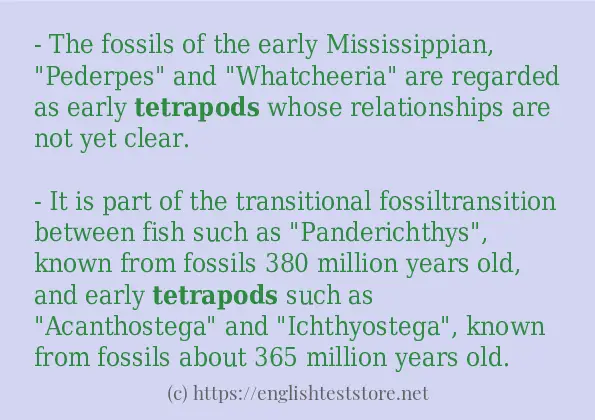How to use in-sentence of “tetrapods”:
– The fossils of the early Mississippian, “Pederpes” and “Whatcheeria” are regarded as early tetrapods whose relationships are not yet clear.
– It is part of the transitional fossiltransition between fish such as “Panderichthys”, known from fossils 380 million years old, and early tetrapods such as “Acanthostega” and “Ichthyostega”, known from fossils about 365 million years old.
– Some tetrapods have evolved the ability to move on two limbs.
– Like other stem tetrapods it has a series of lateral lines across the skull, and rows of teeth on the palate These are basal traits derived from its lobe-finned fish ancestors.
– It appeared in the Upper Devonian about 365 million years ago, and was anatomically intermediate between lobe-finned fishes and the first tetrapods fully capable of coming onto land.Jennifer Clack, “Scientific American”, November 2005.
– This is why some classification schemes put the tetrapods into the Osteichthyes.

Example sentences of “tetrapods”:
– Its relationships with other tetrapods are left unclear.
– Snakes and other legless reptiles are tetrapods because they are evolved from ancestors who had four limbs.
– The earliest tetrapods lived entirely in water.
– This is the earliest known example of this in the large group of tetrapods which includes dinosaurs, crocodiles, pterosaurs and birds.
– Lobe-finned fish in the Devonian evolved into tetrapods in a series of transitional fossils.
– The earliest tetrapods evolved from the Sarcopterygii, or lobe-finned fish, into air-breathing amphibians, perhaps in the Upper Devonian period.Clack, Jennifer 2012.
– These earliest tetrapods were not terrestrial.
– Also, because fossils of early tetrapods are found widely in the Old Red Sandstone continent, formed by the joining of North America and northwestern Europe they must have spread by following the coastal lines.
– These tetrapods appeared during the Pennsylvanian and went extinct at the end of the Permian period.
– Cleidoic eggs must have evolved in the early or middle Carboniferous, “after” the early tetrapods evolved, but “before” the amniotes split into sauropsids.Kermack D.M.
– Between the lobe-finned fish tetrapods and the first amphibia and amniotes in the Middle Carboniferous lies a gap of 30 million years, with few satisfactory tetrapod fossils.
– The early tetrapods split first into two major groups: the amphibians, which laid their egg eggs in water, and the amniotes, who laid their cleidoic eggs on land.
– There are more fish than tetrapods : there are over 33,000 described species of fish.
– It is therefore a transitional fossil, and gives biologists rare information about the development of tetrapods in a time when terrestrial life was scarce.
– Reptiliomorpha is a clade of the amniotes and those tetrapods that share a more recent common ancestor with amniotes than with living amphibians.
- Its relationships with other tetrapods are left unclear.
- Snakes and other legless reptiles are tetrapods because they are evolved from ancestors who had four limbs.
- The earliest tetrapods lived entirely in water.
